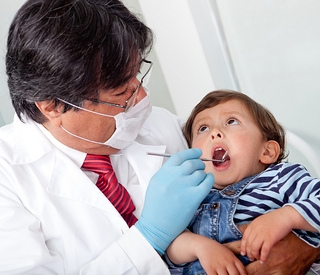January 6th, 2023

You do everything you can to protect your toddler with safeguards large and small. Installing that complicated car seat. Figuring out which sunscreen is best for delicate skin. Spending weeks childproofing your home. But all the work protecting your child is more than worth it because the rewards are so great. And one more everyday precaution that brings great rewards is protecting your toddler from tooth decay.
The time to start your baby’s dental care is even before that first tooth arrives. Carefully wiping the gums with a clean, damp cloth after feeding gets your child used to the idea of brushing and removes bacteria that might irritate the gums as the teeth begin to erupt. As soon as those teeth arrive, gentle brushing with soft bristles will keep bacteria and plaque from causing tooth decay and gingivitis. We can recommend toothpastes formulated especially for toddlers and suggest the best ways to brush.
We know that sugary foods aren’t healthy for your toddler’s teeth. Bacteria in the mouth feeds on sugar, and a sugar-heavy diet results in more of the bacteria and plaque which cause cavities. But sugar is not the only food that is not tooth-friendly. For example, foods like citrus fruits and juices can also be a problem. Acidic foods can actually weaken enamel after eating and leave teeth more vulnerable to cavity-causing bacteria and plaque. We have suggestions for tooth-healthy snacks and the best times to brush after eating if you and your child indulge in a treat.
- Don’t Misuse Bottles & Sippy Cups
Your toddler might still use a bottle at night or a sippy cup throughout the day. Juices and even milk contain sugar that increases the risk of cavities, and if your child goes to sleep with a bottle or cup, these liquids pool in the mouth overnight allowing bacteria to flourish. If your toddler wants a drink at night or between meals, water is a much better option.
Those tiny teeth are important for so many reasons. They enable children to bite and chew efficiently, to pronounce sounds properly for speech development, and to save space for adult teeth so they erupt in the right place. Dr. Connie Verhagen and our team recommend that your child visit our Muskegon, MI office after the first tooth comes in, and always by the first birthday. We will make sure your toddler’s teeth are developing as they should be and suggest ways to keep them cavity-free. Your toddler’s healthy, beautiful smile is a reward worth protecting!
December 30th, 2022

Watching the clock tick down the final seconds until midnight, many of us- West Coast Pediatric Dentistry included- feel nostalgic about the passing year and hopeful about the new one to come. New Year’s Eve is one of the most widely celebrated holidays in the world, with over-the-top celebrations taking place in dozens of countries. The Gregorian calendar, which is widely used in Western nations and around the world, was implemented in 1582. Since that time, December 31st has marked the final day of the year, with midnight heralding the beginning of a brand new year. In the United States, New Year’s Day is a public holiday; government offices, schools, public organizations, and many businesses are closed for the day. Ponder the following fun facts as you think about your plans for the holiday:
- Approximately one billion people watch the New Year’s Eve ball drop in Times Square, New York City. This televised event is one of the most iconic New Year’s celebrations in the world. For many years, watching the ball drop meant tuning in to Dick Clark’s Rockin’ New Year’s Eve, an iconic television special dear to the hearts of many viewers.
- The idea for the New Year’s Eve ball came about because of a citywide ban on fireworks. Before 1907, when fireworks became illegal in New York City, celebrations included an elaborate fireworks show. The large, glittering, illuminated ball was developed as an alternative. Although the first ball was heavy at 700 pounds, the modern New Year’s Eve ball is made of Waterford crystal and tips the scale at six tons!
- The top five New Year’s resolutions are: to lose weight, quit smoking, get a new job, return to school, or increase personal savings. However, approximately 88% of New Year’s resolutions fail. But don’t let that discourage you! Resolutions are most likely to succeed when they are clear, achievable goals. Setting out a concrete plan to achieve your resolution also boosts your chances of success.
- Eating black-eyed peas on New Year’s Day is said to bring good fortune in the new year. Collard greens, cabbage, and ham hocks are also considered lucky foods to enjoy. Just steer clear of the chicken or turkey dinners; eating poultry is a bad omen for the year to come.
Whether you plan to stay in Muskegon, MI, or head out into the crowds to watch the ball drop in Times Square, New Year’s Eve is a time to enjoy friends and family. Send your loved ones well wishes for the New Year, and look for that special someone to share a midnight kiss with for good luck!
December 23rd, 2022

First aid training is a must when you are a parent. You can put on a bandage with your eyes closed. Perhaps even apply butterfly tape to avoid stitches. What about a dental injury? Do you have a checklist in mind on what to do when a tooth is knocked out, broken, or displaced from impact? All of these situations happen often and should be in a parent’s emergency training regiment. Luckily Dr. Connie Verhagen and our team are here to be a resource for such an incident!
Children’s most common dental injury is chipping a front tooth. It is so common that it seems like a right of passage. Say, for example, a two year old trips and hits her front teeth on the tile floor. First, check to see if the teeth have been broken to the nerve. You can tell if you see layers and a pinkish center. Then, wiggle each tooth and make sure it is not loose. If the teeth feel firmly in place, that is a good sign. Even if they are a little loose, the teeth will tighten again with time. If she develops a severe temperature or bite sensitivity then you know treatment is needed, which may include a root canal. If there are minor symptoms that diminish with time, continued observation will be fine.
Knocking out a tooth is also common and requires more attention than observation alone. As soon as possible, locate the tooth, touch only the crown (not the root), and rinse any debris gently with milk or water. Place it back into the tooth socket as soon as possible. The American Association of Endodontists states a tooth has a high chance of survival and retention for life if it is re-implanted within five minutes or up to 60 minutes if soaking in milk or saline solution. Our team at West Coast Pediatric Dentistry know many parents are nervous about the thought of doing this alone, but not to worry, our team is here to help!
Here’s another dental emergency example: Your child takes an elbow to the mouth during a basketball game and severely displaces a tooth but does not knock it out. What to do? First, apply light pressure in an attempt to move it back into place. Be extremely careful not to use excessive force. Place a cold pack for swelling and contact our office as soon as possible.
A dental emergency can be frightening. It is often messy and painful. The best initial reaction is to remain calm, and remember that we are here to help! Contact us at our Muskegon, MI office if your child encounters a dental emergency.
December 16th, 2022

Healthy eating, combined with regular physical activity, plays a vital role in your child’s health and well-being. Dairy foods are naturally nutritious, packed with ten essential nutrients that help your child feel good for life. But did you know that dairy is also great for your child’s dental health? Our team at West Coast Pediatric Dentistry will tell you that, in addition to providing large amounts of much-needed calcium, dairy products also help fight cavities! Dairy products have a specific role to play in dental health as they contain a unique combination of special anti-decay nutrients such as calcium, phosphorus, and the protein, casein. Cheese is especially useful, as eating a small piece of cheese after consuming sugary foods or drinks can help protect teeth and reduce the risk of tooth decay.
If you’d like to know more about the importance of dairy products in your child’s diet, or about any aspect of your child’s dental health, feel free to ask Dr. Connie Verhagen at your next appointment!






 Website Powered by Sesame 24-7™
Website Powered by Sesame 24-7™